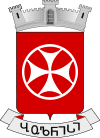Bolnissi
|
Bolnissi ბოლნისი |
||
|
||
| State : |
|
|
| Region : | Niederkartlien | |
| Municipality : | Bolnissi | |
| Coordinates : | 41 ° 27 ' N , 44 ° 32' E | |
| Residents : | 8,967 (2014) | |
| Community type: | city | |
|
|
||
Bolnissi ( Georgian ბოლნისი ) is a city in Georgia . It is located in the Niederkartlien region (Kwemo Kartli) and has 8967 inhabitants (2014). The city goes back to a foundation by Caucasian-German settlers under the name Katharinenfeld in 1818. The current name is derived from the Bolnissier Sioni church from the 5th century, which is located almost 10 km south of the village of the same name .
history
In the spring of 1817, a large wave of radical Pietists from Württemberg emigrated who wanted to flee from being tamed by the authorities. At that time they were called "separatists" because they split off from the regional church. It was driven even more by the hope of the imminent return of Christ, inspired by religious apocalyptic sentiments . The Pietists located the goal of fleeing the distress caused by the incredulous surroundings in the Caucasus because the Russian Tsar Alexander had promised support. The first group of 65 families managed to settle 25 kilometers southwest of Tbilisi in a river valley. Two other groups initially settled 180 kilometers southeast of Tbilisi in the climatically unhealthy place Schamkor ( Alt-Katharinenfeld ). Many died of epidemics the following summer, the remaining settlers moved in the winter of 1819 to what is now Bolnissi, which they called Neu-Katharinenfeld, a few kilometers from the Sioni Church. An Armenian and Greek pilgrimage site was located here on a "Georgsberg".
The name Katharinenfeld was intended to honor the Württemberg Queen Katharina , the sister of Tsar Alexander I. During a Muslim uprising in the South Caucasus in 1826, the city was attacked by Muslim militants. Numerous residents were killed or taken to Turkey as slaves . To commemorate this occurrence and the subsequent reconstruction, a "construction party" was celebrated annually. There were five football teams in the village, a German newspaper, a primary school, a Lutheran church with a choir, a hunters' association, a theater group and a city park. Overall, the settlers soon experienced an economic boom and lived a lively community life. In 1854 they consecrated a church in the middle of the Crimean War .
After the occupation of Georgia by the Red Army in 1921, the name was changed to commemorate Rosa Luxemburg in Luxemburg . In 1941 all Caucasian Germans who were not married to Georgians were deported to Siberia and Kazakhstan . Almost 6,000 people had to leave the city. In 1944 the city was named Bolnissi .
The tower of the Protestant church was demolished by German prisoners of war after the Second World War , and the church was converted into a sports hall. There are currently plans to build a new sports hall and to rebuild the church tower.
Cityscape
Today 85 percent of the population are Georgians. The city lives from viticulture and from growing fruit and vegetables. There is a winery and a brewery . A district that is predominantly inhabited by ethnic Azerbaijanis lies a little outside the main settlement and is called "Kvemo Bolnissi" (German: "Unter-Bolnissi"). Gold is mined in the nearby village of Ratewani . The football club is called Sioni Bolnissi .
The cultural heritage of the former German settlers in Bolnisi is now mainly carried by the community of the Protestant church . In the Protestant parish hall there is a small German-language library and a museum room in which the German history of the city is reported. Some of the services are held in German. Most Evangelical Christians in Georgia come from mixed marriages between Caucasian Germans and other peoples.
Bolnissi is home to one of the oldest Christian churches in Georgia. The Sioni Church dates from the 5th century. Pagan elements can be seen in its masonry. The original roof has been replaced by a covering from the 20th century.
A bilingual plaque commemorates the fate of the German residents in the city center.
City entrance with the "Bolnissi Cross"
literature
- Ernst Allmendinger: Katharinenfeld, a German village in the Caucasus , self-published, Neustadt 1989.
- Andreas Groß: Missionaries and colonists: The Basel and Hermannsburg missions in Georgia using the example of the Katharinenfeld colony; 1818-1870 . Lit, Hamburg 1998, ISBN 3-8258-3728-9 .
Web links
Individual evidence
- ↑ Peter Haigis: "Georgians of German origin" ?! - The Evangelical Lutheran Church in Georgia and its roots. In: Bernd Schröder (Ed.): Georgia. Society and religion on the threshold of Europe. Röhrig Universitätsverlag, St. Ingbert 2005, pp. 90f, 95
- ^ Ernst Allmendinger: Katharinenfeld, a German village in the Caucasus . Self-published, Neustadt 1989
- ↑ Haigis, p. 98









